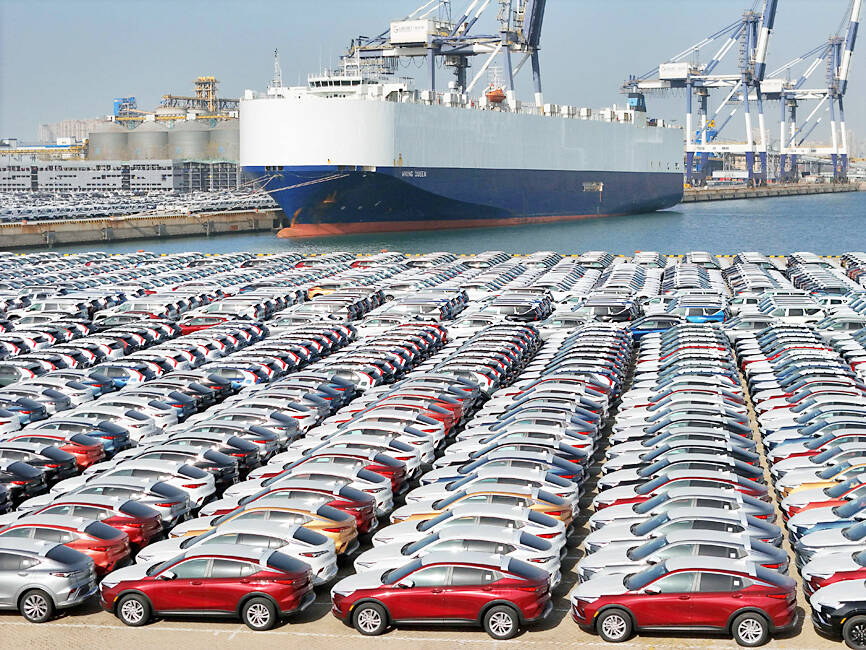China’s exports rose last month, the first increase since April, while imports fell, customs data released yesterday showed.
Exports rose 0.5 percent from a year earlier to US$291.9 billion, a sign that demand might be picking up after months of decline.
However, imports fell 0.6 percent to US$223.5 billion after they climbed 3 percent in October.

Photo: AFP
China has been grappling with sluggish foreign trade this year amid slack global demand and a stalled recovery, despite the country’s reopening after its COVID-19 controls were lifted late last year.
The trade surplus of US$68.4 billion was up 21 percent compared with October’s US$56.5 billion.
Some economists said they doubt the rise, fueled mainly by exports of vehicles and ships, would continue for long.
“Looking forward, the resilience of exports is unlikely to last. The recent strength is at least partly fueled by exporters slashing prices to gain market share,” Capital Economics economist Huang Zichun (黃子春) said in a note, describing the reduction of prices as “unsustainable.”
“Without the support of price cuts, exports are unlikely to defy the slowdown in growth among China’s major trading partners, which we expect to continue in the first half of next year,” Huang said.
Trade with Japan, Southeast Asian countries, the EU and the US has declined this year.
Exports to the US and the EU have fallen by more than 10 percent so far this year from the same period last year, while those to Russia surged 50 percent, the official data showed.
Imports of steel plunged 27 percent so far this year as the property downturn deepened, while chips declined by 16.5 percent.
Demand for Chinese exports has been weak since the US Federal Reserve, and central banks in Europe and Asia began raising interest rates last year to cool inflation that was at multi-decade highs.
“It is unclear if exports can contribute as a growth pillar into next year,” Pinpoint Asset Management Ltd (保銀私募基金管理) chief economist Zhang Zhiwei (張智威) said. “The European and US economies are cooling. China still needs to depend on the domestic demand as the main driver for growth in 2024.”
Additional reporting by Bloomberg

Nvidia Corp’s demand for advanced packaging from Taiwan Semiconductor Manufacturing Co (TSMC, 台積電) remains strong though the kind of technology it needs is changing, Nvidia CEO Jensen Huang (黃仁勳) said yesterday, after he was asked whether the company was cutting orders. Nvidia’s most advanced artificial intelligence (AI) chip, Blackwell, consists of multiple chips glued together using a complex chip-on-wafer-on-substrate (CoWoS) advanced packaging technology offered by TSMC, Nvidia’s main contract chipmaker. “As we move into Blackwell, we will use largely CoWoS-L. Of course, we’re still manufacturing Hopper, and Hopper will use CowoS-S. We will also transition the CoWoS-S capacity to CoWos-L,” Huang said

Nvidia Corp CEO Jensen Huang (黃仁勳) is expected to miss the inauguration of US president-elect Donald Trump on Monday, bucking a trend among high-profile US technology leaders. Huang is visiting East Asia this week, as he typically does around the time of the Lunar New Year, a person familiar with the situation said. He has never previously attended a US presidential inauguration, said the person, who asked not to be identified, because the plans have not been announced. That makes Nvidia an exception among the most valuable technology companies, most of which are sending cofounders or CEOs to the event. That includes

INDUSTRY LEADER: TSMC aims to continue outperforming the industry’s growth and makes 2025 another strong growth year, chairman and CEO C.C. Wei says Taiwan Semiconductor Manufacturing Co (TSMC, 台積電), a major chip supplier to Nvidia Corp and Apple Inc, yesterday said it aims to grow revenue by about 25 percent this year, driven by robust demand for artificial intelligence (AI) chips. That means TSMC would continue to outpace the foundry industry’s 10 percent annual growth this year based on the chipmaker’s estimate. The chipmaker expects revenue from AI-related chips to double this year, extending a three-fold increase last year. The growth would quicken over the next five years at a compound annual growth rate of 45 percent, fueled by strong demand for the high-performance computing

TARIFF TRADE-OFF: Machinery exports to China dropped after Beijing ended its tariff reductions in June, while potential new tariffs fueled ‘front-loaded’ orders to the US The nation’s machinery exports to the US amounted to US$7.19 billion last year, surpassing the US$6.86 billion to China to become the largest export destination for the local machinery industry, the Taiwan Association of Machinery Industry (TAMI, 台灣機械公會) said in a report on Jan. 10. It came as some manufacturers brought forward or “front-loaded” US-bound shipments as required by customers ahead of potential tariffs imposed by the new US administration, the association said. During his campaign, US president-elect Donald Trump threatened tariffs of as high as 60 percent on Chinese goods and 10 percent to 20 percent on imports from other countries.